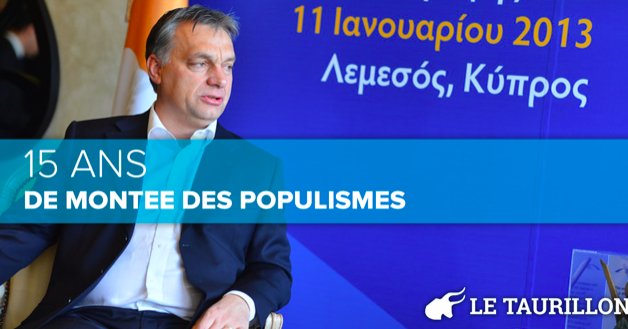The term is sometimes used in a disqualifying manner against political personalities or parties seen an agitator or radical.It can also be fully claimed and theorised, as in the case of Jean-Luc Mélenchon and France Insoumise, who claim to be part of the left-wing populism thought up by Chantal Mouffe. Even more surprisingly, on 22 November 2018 the French president Emmanuel Macron declared to an audience of mayors that they were “true populists”. The President’s usage of the term highlights it’s complexity; Macron took care to distinguish between the “real” populists from “demagogues” and “nationalists”. Before we begin this rapid overview, we can only agree with the observation made by Argentine political theorist Ernesto Laclau: “Populism is an elusive and recurrent concept. Few terms have been so widely used in contemporary political analysis, although few have been defined with less precision. We intuitively know what we are referring when we call a movement or an ideology populist, but we have the greatest difficulty in translating this intuition into concepts.”
Between 2015 and 2018, the number of articles featuring the word “populism” in the French pressed jumped from 486 to 1254 . Le Taurillon is no exception to this trend. While it is now difficult to establish exact figures on the use of the term “populism” by its editors (we must also account for the variations in the rate of publication since the creation of Le Taurillon in 2005), a considerable increase in its use has indeed been noted. After a few searches in Le Taurillon’s database, we can estimate that the more frequent use of the term began when writing about the debates on the reform of the Hungarian Basic Law commissioned by Viktor Orban in 2011.
However, the use of the concept of populism is not limited to this event. It would be a pity to examine it in a monolithic way, without making any pluralist analysis of different populisms (right-wing, left-wing, top-down, identity-based, resistance-based), mentioned in Le Taurillon. This is why in this article I propose a quick overview of the populisms described and, at times, analysed in Le Taurillon since 2005.
Regularly described as a threat to democracy, populism is intrinsically linked to the idea of crisis, a fertile breeding ground from which it would emerge periodically. But should it instead be considered as an inseparable component of European politics? How has the notion of populism evolved since 2005?
Can everyone be a populist?
Even today, there is still no definition that clearly and rigorously describes the concept of populism. This lack of definition may explain its frequent use when describing the positioning of sometimes fundamentally different parties. The first mention of populism in an article by Le Taurillion cannot be determined exactly, but it was used relatively shortly after the failure of the Constitution for Europe in 2005. As early as 2006, some articles lamented the “return of populism and isolationism”, without referring to any one particular party.
Between 2006 and 2010, many articles published in Le Taurillon condemned the “populist” attitude of certain parties within the European Union. However, this was never the main criticism levelled at them. Populism was always linked to other criticisms; the parties were often accused of demagogy, exploitation of European institutions, and nationalism.
Several examples show that the notion of populism was not as important, and did not have the same significance that we give it today. It was flexible notion; it could characterise parties that were ideologically opposed and sometimes not very sensitive to European issues such as the CSU ,the Christian Social Union in Bavaria, whilst others are markedly pro-European, such as the SPD , the Social Democratic Party of Germany. The accusation of populism was a reproach “amongst others”, which did not stand out in practice.
Until Viktor Orbán came to power (for the second time) in 2010, no country in the European Union had been governed by a party that could be qualified as populist. This in particular could explain why the concept before 2010 was extremely vague, as it had never really been applied in practice.
The Establishment vs. the sovereign people
Viktor Orbán’s rise to power in Hungary in 2010, and, above all, the Hungarian National Assembly’s adoption of a new Constitution represented a real turning point in the analysis of populism. To begin with, it was the first time that a party described as populist had won leadership in a European Union Member State. In addition, other political groups and leaders gained power over the following years: in Slovakia, the Czech Republic, Poland, Austria and Italy. Western European countries also experienced a surge of populism, to the extent that, the phenomenon was then examined on a pan-European scale.
In 2012, an analysis entitled “Comprendre le populisme” [“Understanding populism”] was published by Le Taurillon. After many articles devoted to Viktor Orbán’s rise to power, this article brought a new perspective on populism, which would be taken up again thereafter. For the first time, the growth and assumption of the power of populist parties within EU member states were compared. The article was also a space to interrogate the workings, the principles, and value systems of populist parties. The author states that after having understood the characteristics of populism, we must formulate arguments against it.
A new model within the European Union?
Today, the European Union has around thirty parties that could be classed as populist, both right-wing (the majority) and left-wing. At first glance, the similarities between these parties seem significant. The majority do not share the same ideological blueprints and do not have the same demands. Some are more drawn to violence, racism, or the idea of a closed society. These differences explain why populist parties remain divided on the European stage and refuse to sit together in the European Parliament.
Nevertheless, they also have a number of points in common. Populist parties are united in defending sovereignty and protectionism, “defending the people against elites”, and most notably, berating the European Union, which is presented as an anti-democratic, ultra-liberal project. Until recently, several populist parties demanded - sometimes under certain conditions - to leave the European Union. Yet, particularly since the Brexit vote and negotiations, some of these parties have now abandoned this demand. Certain far-right parties like the Le Rassemblement National (France), La Lega Nord (Italy) and the People’s Party (Austria) have asserted their wish to reform the European Union from within, by transforming it into a community of sovereign states.
In Eastern Europe, leaders opposed to strengthening the European Union, without arguing to dismantle it, have come together in the Visegrád Group. In Western Europe, several Eurosceptic parties are forming cross-border alliances, and espouse a new vision of Europe based on the functioning of nation-states. This strategy seems to be fruitful. All over Europe, Eurosceptic parties continue to gain ground thanks to discourse that combines Euroscepticism with a desire to establish a network of communications and alliances in Europe.
Populism is probably one of the most striking developments in European political life over the last fifteen years. Although the concept is still relatively abstract, it takes on its full meaning when studied at the level of the European Union. Populism demands a return to nation states, which it considers the basis of functional democracy, and opposes European institutions. Pro-Europeans reject this notion and advocate a strengthening of European integration.
The system containing these two opposing visions of European integration is now becoming the norm on the European stage, as shown by the last European elections in 2019 and several national elections, where parties defending European integration face Eurosceptic parties. Populism now seems to have become an inescapable part of European political life.


Follow the comments: |
|
